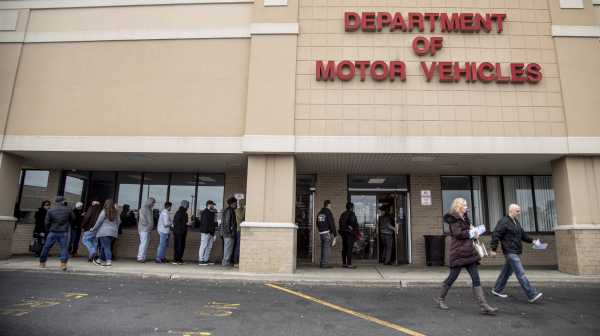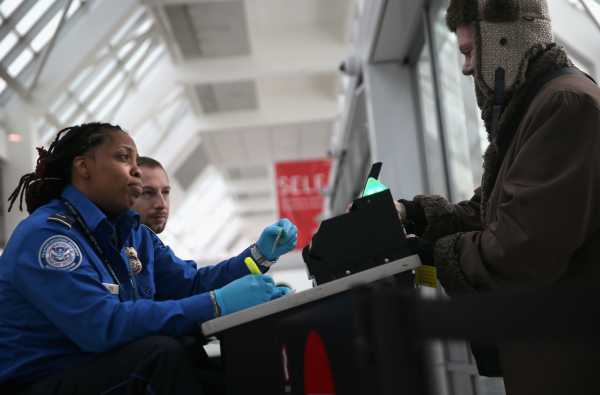
This story is part of a group of stories called

On October 1, travelers in the US will need a new type of identification card to fly domestically: a Real ID. Most current driver’s licenses will no longer be accepted by the Transportation Security Administration, which means travelers will need to show another form of federally accepted ID, like a US passport or permanent resident card, to make it past security and onto their flight. The rule also affects people looking to access federal facilities and nuclear power plants.
The result of this impending change? Overcrowded DMVs, long lines and waits, and mass confusion. Already, stories of bureaucratic chaos at local DMVs are emerging, and airports are bracing for the October deadline. Headlines like “Get in line now. California’s DMV is really, really behind in issuing Real IDs” and “Need a new driver’s license to fly? Prepare for a real wait” have sent people scrambling to schedule appointments to secure a new ID. As of January 2020, DHS reported that 95 million driver’s license holders have been issued Real IDs. That means there are still 181 million people who need to upgrade their licenses.
The Department of Homeland Security has spent years trying to implement federally standardized identification at the state level. As of 2016, 32 states were still not compliant with Real ID requirements, which led DHS to extend the time frame for the program. The deadline appears to be final this time. All 50 states are on track to issue these updated licenses by October 1, according to DHS. If you choose to not get a Real ID this year, your driver’s license is still valid for other things besides plane travel, like driving, age verification, or voter registration.
According to a survey by the US Travel Association in September, most Americans are confused about the Real ID requirements. More than half said they didn’t know about the October 1 deadline, and 39 percent said they didn’t have an alternative like a passport. Still, despite Americans’ uncertainty surrounding these new ID requirements, the law is on track to be implemented in about eight months — nearly 15 years after the original legislation was approved in Congress. Here are some answers to the questions that might be on your mind as October 1 approaches.
What’s the purpose of a Real ID?
In response to the 9/11 terror attacks, the House of Representatives passed the Real ID Act in 2005 to establish a federal standard for driver’s licenses and identification cards. The legislation aimed to effectively change how these documents are issued and produced to reduce the possibility of forgery and fraud. (Some of the 9/11 terrorists obtained state licenses through fraudulent documents by taking advantage of certain loopholes to prove their identity and residency.) As DHS writes on its website, “The purpose of Real ID is to make our identity documents more consistent and secure.”
While the act was signed into law more than a decade ago, most states didn’t get around to creating and issuing compliant IDs until 2018. The original act was packaged with an $82 billion spending bill that authorized funds for the Iraq War and tsunami relief in Southeast Asia.
After the law was passed, about half of the 50 states objected to the program, and some even passed laws to stop their DMVs from caving to federal pressure, the Washington Post reported. Over the years, DHS has steadily extended the deadline of the program’s rollout, finally settling on October 1, 2020, as the date that every air traveler will need a compliant license to board a domestic flight.

Is there anything wrong with a noncompliant license?
No. Your driver’s license is still valid until its expiration date unless you’re flying domestically, accessing a federal building, or entering a nuclear power plant. You’ll still be able to drive, verify your age and identity, and vote with a regular ID.
The Real ID isn’t physically very different from the current state licenses. (There’s the addition of a star in the top right corner of the card.) The biggest change is the process of how someone gets an ID card, which makes it more secure by federal standards.
Before the Real ID program, states had varying rules and document requirements for how someone acquired a driver’s license. All states are now subjected to the same guidelines, which require a person to show up to a local DMV with documents that show their legal name, date of birth, Social Security number, two forms of proof of address, and citizenship or immigration status. (The DHS website suggests you check your state’s document requirements before going to the DMV.)
The biggest change is the process of how someone gets an ID card, which makes it more secure by federal standards
Residents of Michigan, Minnesota, New York, Vermont, and Washington who have an enhanced driver’s license will still be able to use these cards to pass through airport security. Enhanced licenses are only available in those five states and allow holders to easily enter the US from Canada, Mexico, or the Caribbean.
What will happen if a person shows up for a flight with a regular ID?
Travelers, even those with TSA PreCheck, won’t be allowed to board a flight without a Real ID or an equivalent form of documentation like a passport or military ID. If a person shows up on October 1 with only a regular driver’s license, TSA won’t allow them to board.
Airport officials are worried that passengers will arrive for their flight without a Real ID or proper credentials. In the past, a person could undergo “more enhanced, very intrusive type of screening” to verify their identity, Frank Miller, executive director of the Hollywood Burbank Airport, told the Los Angeles Times. This won’t be allowed anymore.
How will this affect non-US citizens, undocumented immigrants, and other vulnerable populations?
Since the Real ID’s proposal in 2005, critics have argued that it would be another roadblock for undocumented immigrants and noncitizens to receive identification. The documents needed to verify a person’s identity and residence for a Real ID — things like a passport, birth certificate, and Social Security card — are tangentially related to their citizenship, immigration status, and even economic security.
“One of the things Real ID does is that it turns motor vehicle officials into immigration enforcements,” Jay Stanley, a policy analyst for the American Civil Liberties Union, told Vox. “Immigration law is very complicated, and this puts motor vehicle clerks into a position where they’re making judgments about people’s immigration status.”
If a person wasn’t born in the US and wants to register for a Real ID, they will have to provide a permanent resident card (green card), an immigrant visa, or a foreign passport with temporary evidence of their permanent residence. States can also issue temporary Real ID cards to anyone who provides “valid, documentary evidence that they have ‘approved deferred action status,’” according to the DHS website.
This applies to immigrants who qualify under the Deferred Action for Childhood Arrivals program, provided they have a Social Security number and employment authorization documents. However, this policy disqualifies a majority of undocumented immigrants who aren’t protected under DACA.
“This puts motor vehicle clerks into a position where they’re making judgments about people’s immigration status”
While undocumented immigrants will still be able to apply for standard driver’s licenses from the 15 states that provide them (plus Washington, DC), these cards will be clearly different from the state’s Real IDs. DHS requires these noncompliant licenses to have “a unique design or color” and to clearly state that they’re not an acceptable alternative to a Real ID.
Critics have voiced concerns over these proposed differences. As the Los Angeles Times’s David Ulin wrote in a 2018 op-ed, “Equally troubling is the further development of what we might call a two-tier America, based on immigration status and economic opportunity. Even the Department of Homeland Security acknowledges that noncompliant IDs could be a red flag for discrimination.” He cited an FAQ from the DHS website that “cautions against assuming that possession of a noncompliant card” indicates that a person is undocumented.
The program is at risk of placing undue burden on not just immigrants but citizens — particularly low-income or older people who are unable to obtain the proper documents to prove their identity, the ACLU has argued. This issue, which has been raised when it comes to voter registration, affects about 11 percent of Americans across the country, who don’t have government-issued photo ID cards (like a driver’s license or a passport). These documents often require a person to pay fees (an application for a passport is $110, in addition to a $35 execution fee) and potentially have to take time off work to visit the DMV.
What are the privacy implications of this act?
Privacy and civil liberties advocate groups, including the ACLU, Electronic Frontier Foundation, and Center for Democracy and Technology, have opposed the Real ID program since its passage in 2005. Some have called for its repeal or a major amendment to the act, arguing that the Real ID moves the US one step closer to establishing a national identity card and database.
On its website, DHS established that Real ID “does not create a federal database of driver license information,” meaning that each state or territory will continue to have its “own unique license, maintain its own records, and control who gets access to those records and under what circumstances.” However, the law still requires a state to “provide electronic access to all other states to information contained [in its] motor vehicle database.”
While many countries around the world have a national ID card, especially in Europe and Asia, US lawmakers and the general public have been skittish about adopting a program that could affect Americans’ civil liberties. A national ID system could infringe on citizens’ freedom of privacy, critics say, if law enforcement and other government agencies could potentially have access to and monitor people’s private information.
In a blog post, the Electronic Privacy Information Center called for an “alternative model of a system of decentralized identification,” writing that DHS has not made the Real ID system safe enough against security breaches and misuse of personal information.
“Instead of having a centralized identity database, what Real ID has done is create a distributed identity database with pointers to all the state DMVs,” said Stanley of the ACLU. The program he’s referring to is called the State-to-State data sharing system, which is the easiest way for states to comply with the Real ID Act (although they’re not required to).
The biggest concern for privacy advocates is whether these IDs could allow for broader surveillance of individuals. According to Stanley, there are still a lot of unanswered questions: “Will ICE [Immigration and Customs Enforcement] have access to people’s information? Will there be identifiers between people who have Real IDs and people who don’t? The purpose of the state DMV is to protect safety on the highway, not to be an identity provider.”
How do you get a Real ID?
The process of applying for a Real ID varies depending on the state, but most require residents to make an appointment online before showing up at their local DMV. DMVs across the country have reported a surge in wait times as the October deadline inches closer. Residents, even those who have made appointments, have said the process took much longer than their previous ID renewals.
According to DHS, a person should check the requirements on their state’s DMV site to make sure they have the necessary paperwork, but at a minimum, they must provide documents showing full legal name, date of birth, Social Security number, two forms of proof of address of principal residence, and citizenship or immigration status.
On February 19, DHS announced it will allow states to accept documents for Real ID applications electronically, in an effort to expedite the registration process. However, applicants are still required to show up in person at the DMV. Some states are doing a slow rollout of the Real ID program: New Jersey is starting with only a handful of DMV offices and gradually expanding as the deadline approaches. It’s also testing walk-ins at some offices, since “demand outstrips the number of available Real ID appointments” currently available.
Remember, if you have a passport or other TSA-approved documents, there’s really no rush to get in line for a Real ID. But if you’re antsy to get one early, the best thing to do is to make a reservation. Chances are, you’ll probably have to wait.
Sign up for The Goods’ newsletter. Twice a week, we’ll send you the best Goods stories exploring what we buy, why we buy it, and why it matters.
Sign up for the
newsletter
The Goods
Email (required)
By signing up, you agree to our Privacy Notice and European users agree to the data transfer policy.
For more newsletters, check out our newsletters page.
Subscribe
Sourse: vox.com






